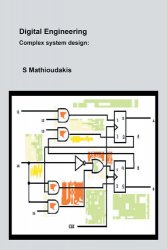Digital Engineering: Complex System Design
- Добавил: literator
- Дата: 24-08-2024, 20:07
- Комментариев: 0
 Название: Digital Engineering: Complex System Design
Название: Digital Engineering: Complex System DesignАвтор: S. Mathioudakis
Издательство: AuthorHouse UK
Год: 2024
Страниц: 178
Язык: английский
Формат: pdf, epub, mobi
Размер: 10.7 MB
This text book offers the reader an overview into creating a computer from an electrical design perspective. Throughout the book are a number of diagrams explaining how a computer would be designed as a circuit. The expectation of the author is to simplify the process of designing computers by explaining how it would be possible to implement a simple process. The book itself looks at a 16 bit computer with a few sets of instructions. Detailing the processes involved in design.
The edition of this book takes the concept of embedded circuits to a higher level of functionality. The text is aimed at the design of a computer system from the concept of digital logic to the design of FPGAs ad CPUs. The text offers a detailed look at the circuitry needed to design a computer from an electrical and electronic perspective.
The purpose of this textbook is to outline and explore some of the assumptions and structures, which underpin the design of digital systems. The intention is that the reader is then able to create their own processes and design their own digital circuits. The book achieves these aims in a number of ways, the system inside a computer is broken down into a number of structures, such as I/O communication and CPU design. Hopefully explaining how these parts work and what tasks they carry out during a programme or performing complex procedures. The book is split into a number of parts which look at digital logic design, creating the structures within components and finally deals with the subject of designing small systems. Each part tries to investigate how a computer might work at a basic level and describes other structures needed in larger computers like todays 64 bit machines.
FPGAs are systems which are able to coordinate processes which tend to repeat themselves. This differs from a CPU as a computer processor is programmable and needs to be dynamic to a range of commands. FPGAs are used to conduct the same procedure again and again. For instance a spectrum analyser for a radio or sound device needs to be able to continually select the same signals from a multitude of potential inputs. The FPGA is used to repeat the same process. Selecting the correct signal each time it is requested. These types of devices are used a lot in computerised systems as they are able to be used in a number of systems to create quick calculations a processor is then able to respond to. In fact FPGAs are a common interface to use in a range of devices and it is possible to design a system for many types of use.
Suitable for those who are ready to design and program their own system.
The book covers the following topics:
Combinational circuits
Instruction addressing
Digital techniques
Systems with memory
Arithmetic unit design
Control unit approaches
I/O interfaces
Sound and visual processing
CPU and FPGA design
Contents:
Скачать Digital Engineering: Complex System Design
Внимание
Уважаемый посетитель, Вы зашли на сайт как незарегистрированный пользователь.
Мы рекомендуем Вам зарегистрироваться либо войти на сайт под своим именем.
Уважаемый посетитель, Вы зашли на сайт как незарегистрированный пользователь.
Мы рекомендуем Вам зарегистрироваться либо войти на сайт под своим именем.
Информация
Посетители, находящиеся в группе Гости, не могут оставлять комментарии к данной публикации.
Посетители, находящиеся в группе Гости, не могут оставлять комментарии к данной публикации.

